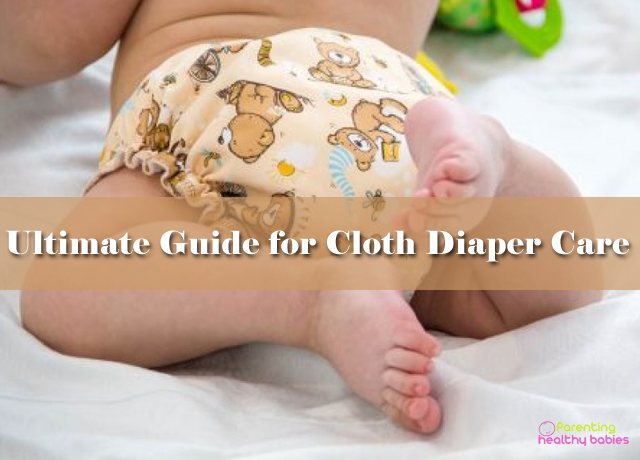Cloth diapers are extra special to care for opposed to a disposable diaper that is as simple as a toss in the trash can wipes and all. As an experienced cloth diapering parent or as a beginner you may have some totally valid concerns and questions when it comes to the proper approach to caring for your diapers.
There are few things that can completely destroy a cloth diaper and there are those go-to tricks to strip the bad smells from a diaper that sat a little too long. Kids and babies have extra sensitive skin on their bums and it’s up to us as parents to use the best soaps and care methods to meet the standards for the type of cloth diaper you have. So let’s break down the right kind of care cloth diapers across the board need to stay in good condition and overall very clean.
Read More: 11 Benefits of Using Cloth Diapers for Infants
How do Cloth Diapers Stay Clean from Bacteria Build Up
If your a parent or soon to be parent you will come to find that diapers stink. This stink is generally caused by ammonia from the toxic waste being released from your child through urine. This can get built up and ‘stained’ into the cloth diaper if it is not cleaned properly. This build up can cause ammonia burns on your baby’s delicate skin or just a really nasty smell that doesnt seem to ever come out.
Well here are a few ways that you can remove the ammonia causing bacteria in a cloth diaper. You should know that if this happens to your diapers it means they are not getting clean enough when you are running them through the cycle you use to care for them and should take further measures to care for the diapers on a daily basis.
Read More: 12 Awesome Home Treatments for Diaper Rash
Getting ammonia out can seem tricky; especially because the smell is horrible after it has been through a few uses. You will notice the smell seems to get worse with each soil and the smell reeks out even faster than the time before. Use these tips to cut the stench upon first contact:
Change up your detergent, not all laundry soaps work well with cloth diapers; specifically scented laundry detergents tend to linger in your diaper and mesh with the natural scents of the soil creating a very toxic blend of bacteria and artificial scents. Going with a scent free soap is best.
Read More: 11 Common Skin Problems in Children
Add Borax or Calgont to your wash, if ammonia smell has built up due to laundry detergent or just because the diapers aren’t getting clean enough. You can give the diapers an extra washing boost with these two agents. They tend to give that extra kick needed to strip the ammonia from the cloth.
Boil Your Diapers, a tried and true trick for diapering parents seems to be to simply boil the diapers in plain water. A good strong boil for roughly 15 minutes should do the job. If your diapers have plastic snaps or elsewhere be attentive to not melt this portion of the closure system.
Add some Enzymes to The Soak Bucket, they literally will consume the harmful bacteria that is accumulating to create that nasty stench. This type of soak will give you just the right positive fight back to overpower the bacteria that is being built up to cause the ammonia smell. BioKleen Bac out is recommended for this purpose.
Soak & Strip Method, if all else fails or maybe you would like to implement the soak and strip method at least once a month to your routine to ensure that ammonia build up doesn’t occur. You can go with the soak and strip method and adjust it to your habits as needed for your children’s diapers. First, you will get the diapers soaking in as hot of water as you can manage, next add a few things to the soak: 3 tbsp of borax or other wash soda, half a cup of detergent and allow it to soak for roughly 4 hours or overnight — finish out the wash cycle and then add cold water per regular wash and a bit of homemade bleach (½ cup of borax plus 1 cup of peroxide). Allow this to soak for 45 minutes and then finish out the wash cycle with a regular amount of laundry detergent.
Read More: 11 Common Skin Problems in Children
Sun Bleach your Diapers, if it is summer you can use the sun’s natural heat and rays to remove harmful bacteria in your cloth diapers. In order to do so, run the diapers through a regular wash cycle and then use a line to hang the diaper or lay them out over a fence or flat on the cement ground. Allow them to sit in the heat of the sun for at least 4 hours. You can spray lemon juice on the diapers to remove stains during this process.
While ammonia can be extra annoying it is something that must be cared for properly to be takin care of. After you try any of these methods be sure to run them through a regular wash and dry cycle to ensure the diapers have been dried correctly.
Closure Snaps, Velcros, and Snappis
There are a total of about 5 different types of cloth diapers and each one may or may not have a slightly different type of closure system. The most common closures in 2018 are Snaps and Velcro though there are other very convenient closures like the Snappis which are absolute best if possible. Each type of closure comes with different ways to care for it and ensure it’s longevity.
Snaps, you will want to be sure to check snaps for soil or other things that can possibly get stuck in the grooves of the circles that hold the snap together. Don’t ever force a snap shut if it is resisting the force; check that there is nothing blocking the function from working as intended. Remove anything that is caught in between like cloth or food as needed proceeding to close without forcing it to breaking point.
When storing, cloth diapers with snaps it is best to snap them together after folding the diaper properly. Stacking each diaper on on top of the other in a dresser or aired bag that the diapers can easily breath through.
When washing, snaps you will leave unattached and opened for the wash and dry cycle; this leaves plenty of space for any soil to wash out of the snaps and the entire diaper.
Velcro, if the closure on your diaper is made of velcro you will want to check for any hair or fuzzies that can get stuck in the velcro and cause it to not work properly. This easily happens but can be removed with scissors or just the tug of your fingers. You will want to be sure that the velcro is contacted on all areas when your baby is wearing the diaper to ensure that baby’s skin is not going to be rubbed to irritation by any pokey corners of the velcro closure; this is especially important around the thigh area.
When storing, a velcro closure diaper you will want to contact and close all areas of the velcro closure to avoid any unwanted hair and strings or fuzzies when they sit. It also keeps the velcro closure in tip-top shape; make sure that all corners or edges of the velcro area are in contact. Fold and put away diapers in a proper ventilated storage space.
When washing, a velcro closure you will want to be sure that the closure if close in itself so that during the wash it doesn’t pick up extra fuzz or strings of fabric during the wash and dry cycles. Velcro usually attaches easily to other fabrics and you won’t want all of your diapers sticking together.
Snappi type Closure, for these types of closures they will not be run through the washer and dryer at all as this could easily melt or break the closure.
When storing, it is best to just have a small cool dry tupperware bucket or drawer dedicated to holding these types of closures that is in reach and easy to find when changing your child.
When washing, you will wash them in hot soapy water. Not boiling water though as this rapidly break down the materials that are utilized in a Snappi or Boingo.
Cloth diapering can be as convenient and easy as disposable diapers and it is well worth the organic benefits of the system and how it works. There are some very important extra care steps that are needed to maintain the quality and longevity of the cloth.













